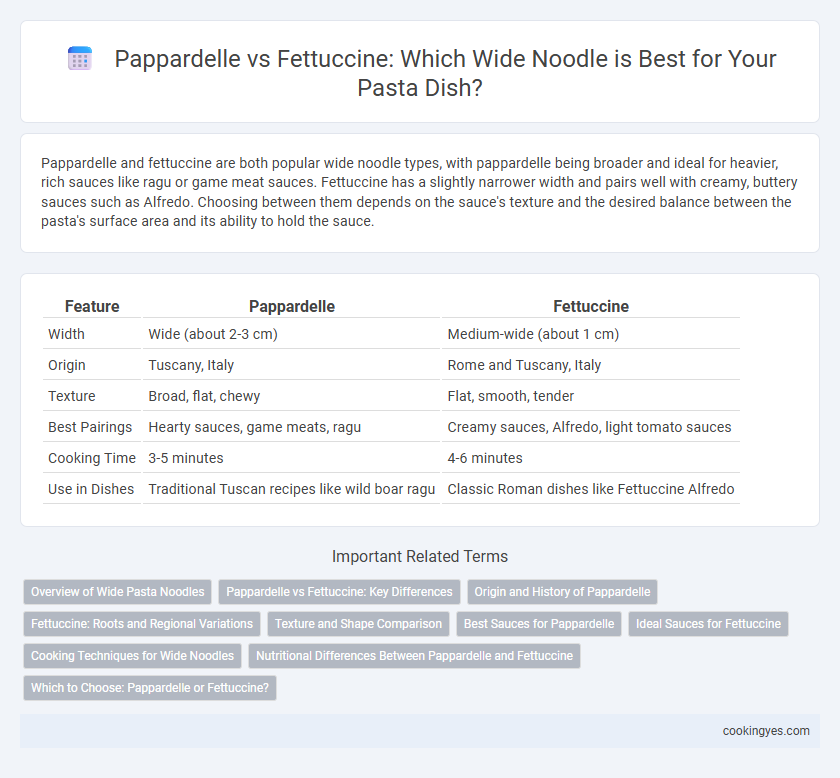Pappardelle and fettuccine are both popular wide noodle types, with pappardelle being broader and ideal for heavier, rich sauces like ragu or game meat sauces. Fettuccine has a slightly narrower width and pairs well with creamy, buttery sauces such as Alfredo. Choosing between them depends on the sauce's texture and the desired balance between the pasta's surface area and its ability to hold the sauce.
Table of Comparison
| Feature | Pappardelle | Fettuccine |
|---|---|---|
| Width | Wide (about 2-3 cm) | Medium-wide (about 1 cm) |
| Origin | Tuscany, Italy | Rome and Tuscany, Italy |
| Texture | Broad, flat, chewy | Flat, smooth, tender |
| Best Pairings | Hearty sauces, game meats, ragu | Creamy sauces, Alfredo, light tomato sauces |
| Cooking Time | 3-5 minutes | 4-6 minutes |
| Use in Dishes | Traditional Tuscan recipes like wild boar ragu | Classic Roman dishes like Fettuccine Alfredo |
Overview of Wide Pasta Noodles
Wide pasta noodles such as pappardelle and fettuccine differ primarily in width and texture, with pappardelle typically measuring around 2 to 3 centimeters wide, offering a broader, more rustic bite, while fettuccine ranges from 0.6 to 1 centimeter, providing a thinner, silkier texture. Both types are traditionally made from egg-based dough, resulting in rich, firm noodles that hold up well to hearty sauces such as ragu or Alfredo. Their versatility in pairing with both chunky meat sauces and creamy dressings makes them staples in Italian cuisine.
Pappardelle vs Fettuccine: Key Differences
Pappardelle and fettuccine are both wide Italian pasta types, yet pappardelle typically measures about 2-3 cm in width, making it broader than fettuccine, which is usually around 0.6-1 cm. Pappardelle's broader ribbons create ideal pairing with robust, hearty sauces like wild boar ragu, while fettuccine's narrower strands complement cream-based sauces such as Alfredo. The texture of pappardelle offers a chewy bite that holds thick sauces well, contrasting with fettuccine's smoother, silkier texture that blends seamlessly with lighter, rich condiments.
Origin and History of Pappardelle
Pappardelle, originating from the Tuscany region of Italy, dates back to the Renaissance period and is traditionally made from egg pasta dough, characterized by its broad, flat ribbons wider than fettuccine. This wide noodle was historically paired with rich game meats and hearty sauces, reflecting Tuscan culinary heritage. Unlike fettuccine, which hails from Rome and is slightly narrower, pappardelle's distinct size and texture highlight its unique regional origins and traditional use.
Fettuccine: Roots and Regional Variations
Fettuccine, originating from the Lazio region of Italy, features long, flat ribbons slightly narrower than pappardelle, making it ideal for creamy sauces like Alfredo or carbonara. Variations across Italy include thicker, hand-cut versions in Tuscany and thinner, delicate strands in Emilia-Romagna, showcasing regional preferences for texture and sauce pairing. This wide noodle's adaptability highlights its cultural significance and enduring popularity in traditional Italian cuisine.
Texture and Shape Comparison
Pappardelle features broader, flatter ribbons typically about 2 to 3 centimeters wide, delivering a chewy yet tender texture ideal for hearty sauces. Fettuccine, narrower at approximately 6 to 7 millimeters wide, offers a slightly firmer bite and pairs well with creamy or lighter sauces. The wider surface area of pappardelle allows it to hold chunky ingredients more effectively, while fettuccine's size offers a balanced mouthfeel suited for a variety of dishes.
Best Sauces for Pappardelle
Pappardelle, with its broad, flat shape, pairs exceptionally well with rich, hearty sauces like ragu, wild boar, or mushroom cream sauces that cling to its wide noodles perfectly. Its texture complements robust flavors often found in slow-cooked meat sauces or thick, earthy vegetable blends, enhancing the overall dining experience. Unlike thinner fettuccine, pappardelle's size and structure make it ideal for hearty sauces that require a substantial noodle to maintain balance.
Ideal Sauces for Fettuccine
Fettuccine, known for its flat and thick strands, pairs perfectly with creamy and rich sauces such as Alfredo or Bolognese, which coat the noodles evenly. The wide noodles hold hearty meat sauces, mushroom-based ragus, and velvety cheese sauces, enhancing the overall texture and flavor experience. Unlike pappardelle, fettuccine's slightly narrower width makes it versatile for both light cream sauces and robust tomato reductions.
Cooking Techniques for Wide Noodles
Pappardelle and fettuccine require careful attention to thickness and cooking time to achieve ideal texture; pappardelle, being wider and thicker, benefits from a slightly longer boil of 3 to 5 minutes to cook evenly without becoming mushy. Fettuccine, thinner and narrower, cooks more rapidly, typically in 2 to 4 minutes, and demands constant stirring to prevent clumping due to its delicate structure. Both wide noodles excel with slow-simmered sauces, as their broad surface holds rich, hearty mixtures like ragu or Alfredo effectively.
Nutritional Differences Between Pappardelle and Fettuccine
Pappardelle and fettuccine both offer similar calorie counts per serving, typically around 200 calories per cooked cup, but pappardelle often contains slightly more carbohydrates due to its wider surface area. Protein content remains almost identical, averaging about 7 grams per serving, while fiber levels depend on whether whole wheat or refined flour is used. Micronutrient variations are minimal, though whole grain versions of both noodles provide higher iron and B vitamins compared to their refined counterparts.
Which to Choose: Pappardelle or Fettuccine?
Pappardelle and fettuccine are both wide Italian noodles, but pappardelle typically measures about 2 to 3 centimeters in width, making it broader than fettuccine, which is around 1 centimeter wide. Pappardelle's wide surface is ideal for holding rich, hearty sauces like ragu or game meat sauces, while fettuccine pairs well with creamy Alfredo or lighter tomato-based sauces. Choosing between them depends on the sauce's texture and the dish's heaviness, with pappardelle favored for robust, substantial meals and fettuccine suited to more delicate or creamy preparations.
Pappardelle vs fettuccine for wide noodles Infographic

 cookingyes.com
cookingyes.com